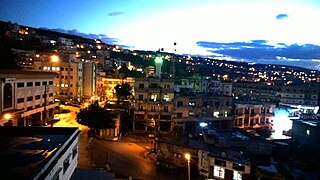Miniara is a village in Akkar Governorate, Lebanon, 9 kilometers east of the Mediterranean Sea, and 3 kilometers south of Halba. The population is between 7,000 and 10,000.

Halba is the capital of Akkar Governorate in northern Lebanon, close to the border with Syria. It is located at around 34°33′2″N36°4′41″E. Its population is divided between Sunni Muslim, Greek Orthodox Christians, Maronites, and followers of other religions.

Qaa, El Qaa, Al Qaa, Qaa Baalbek or Masharih al-Qaa is a town in Baalbek-Hermel Governorate, Lebanon. A 2010 report stated that population of the settlement was 500, all Lebanese Maronites-Catholics.
Cheikh Mohammad is a village situated in Akkar Governorate, Lebanon. Situated 400 metres above sea level, in between two mountains, it overlooks the Akkar plains and sea. It is made up of approximately 450 houses, with 99% of the population being Christian, mostly Greek Orthodox, Melkite Catholics and Maronites. This small village contains two schools, a primary and secondary as well as two churches, one dating back hundreds of years. It also has the first hospital in Akkar, named "Akkar Rahal Hospital".
Lebanese Turkmen, also known as the Lebanese Turks, are people of Turkish ancestry that live in Lebanon. The historic rule of several Turkic dynasties in the region saw continuous Turkish migration waves to Lebanon during the Tulunid rule (868–905), Ikhshidid rule (935–969), Seljuk rule (1037–1194), Mamluk rule (1291–1515), and Ottoman rule (1516–1918).
Andaket, Aandqet, is a Maronite Christian village in Akkar Governorate, Lebanon.
Kouachra is a village in Akkar Governorate, Lebanon. It is located approximately 131 kilometres (81 mi) north of Beirut and 38 kilometres (24 mi) north of Tripoli.

Bire Akkar is a small town in Akkar Governorate, Lebanon, close to the border with Syria.
Bebnine is a town located in the Akkar District of the Akkar Governorate in Lebanon. Its inhabitants are primarily Sunni Muslims.
Beino - Qboula is an area in the Akkar district in Lebanon. Beino has a total area of around 20 Square kilometers with a population of about 2,500.
Tleil is a town in Akkar Governorate, Lebanon, close to the border with Syria.
Jebrayel is a small town in Akkar Governorate, Lebanon.
Cheikh Taba is a town in Akkar Governorate, Lebanon, close to the border with Syria.
Ain Yaaqoub is a village in Akkar Governorate, Lebanon.
Rmah is a town in Akkar Governorate, Lebanon, close to the border with Syria.
Aaouainat is a town in Akkar Governorate, Lebanon.
Hayzouq is a town in Akkar Governorate, Lebanon.
Menjez is a town in Akkar Governorate, Lebanon, close to the border with Syria.
Aadbel is a small town in Akkar Governorate, Lebanon.

Machha is a town in Akkar Governorate, Lebanon. Its population comprises mostly Sunni Muslims.





